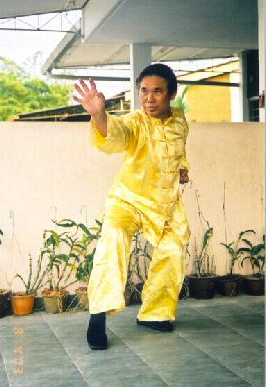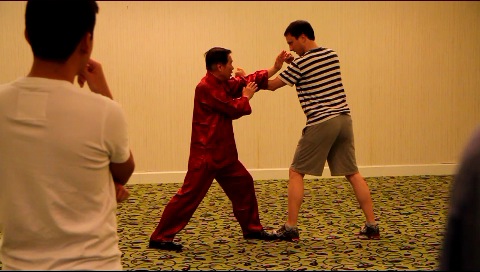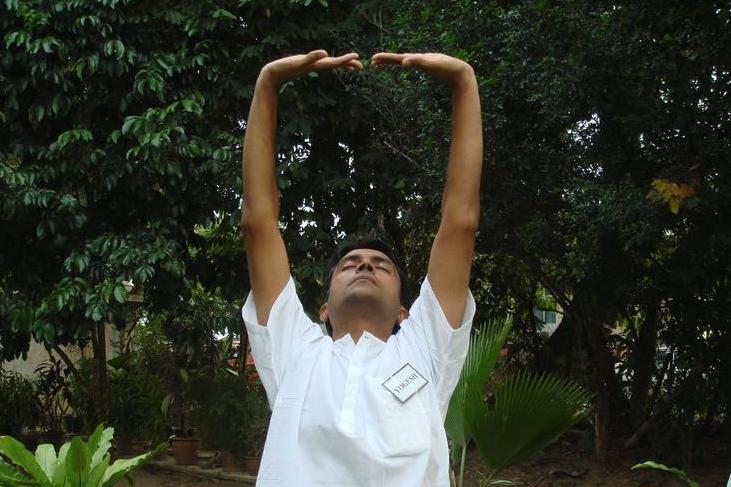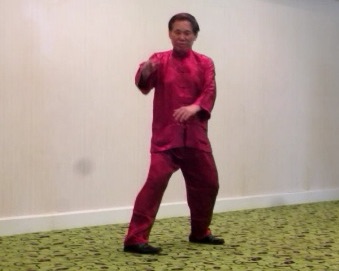SELECTION OF QUESTIONS AND ANSWERS
NOVEMBER 2013 PART 2

In this poise pattern, Single Tiger Emerges from Cave, the minister-hand is held at the waist
Question 1
Why is the rear hand kept beside the hip for the forms "Lohan Asks The Way" and "Black Tiger Steals Heart" rather than letting the rear hand come up in front of the sternum to guard the center line as many short and middle range fighting systems do such as Ngo Chor?
— Sifu Gord Pfeffer, Shaolin Wahnam Canada
Answer
This is an interesting question, and will benefit many kungfu practitioners. In my young days, I thought of this question too, and had similar conclusions.
In kungfu terminology, the leading hand is known as kuan-sau in Cantonese, or the emperor-hand, and the secondary hand known as shen-sau or the minister-hand. Please note that emperor and minister here are figurative, like emperor-medicine and minister-medicine, and do not refer to imperial posts of the empire.
In the case of "Lohan Asks the Way", the left hand is the emperor-hand, and the right hand is the minister-hand. In the case of "Black Tiger Steads Heart" the right hand is the emperor-hand and the left hand is the minister-hand.
In both cases, the minister-hand is kept at the waist instead of in front of the chest as a guard hand. In my younger days, I also thought it would be safer to have the minister-hand in front of the chest or near the shoulder of the emperor-hand. Indeed, I did that in my practice as well as sparring.
However, from direct experience I did not find placing the minister-hand in front or near the shoulder advantageous. In fact I found it more comfortable placing the minister-hand at the waist.
I remember asking my sifu, Sifu Ho Fatt Nam, whether it was advantageous placing the minister hand in front or near the shoulder. He answered that we could place it there if we wanted to be assured of our safety. We should place it wherever it served its purpose best.
Thus, if I want to tempt an opponent to attack so that I can surprise him with a planned counter, I place my minister-hand at my waist. If I am close to an opponent and ensure safety first, I place it in front or near the shoulder. When I am far away from an opponent's target, like while chopping at an opponent's attacking arm as in False Leg Hand Sweep, I place the minister-hand at the waist.
Fierce Tiger Speeds through Valley is a good example. When we purposely expose ourselves to tempt an opponent to attack, we place our minister-hand at the waist. When we strike an opponent with our emperor-hand after deflecting his attack with our minister-hand, we place it near our shoulder. When we press into an opponent, we place our minister-hand near the elbow or our attacking hand.
In Goh Chor or Wuzuquan, which is excellent for short and middle range fighting, the minister-hand is often placed at the breast level, not in front to guard the centre line.
Question 2
Is it to ensure that students learn to use the forward arm independently before using combined motions that use both the front and rear hand at the same time?
Answer
Yes, but this is only part of the reason. We can place the minister-hand anywhere when we wish to focus on using the emperor-hand independently.
In the past some masters used their minister-hand to smoke a pipe while sparring with only their emperor-hand. I use my minister-hand "to drink tea" while felling an opponent in some demonstrations.
On the other hand, students should place their minister-hand at an appropriate position even when they focus on using their emperor-hand. This is to ensure their own safety as well as position their minister-hand for a surprised attack. In Taijiquan Pushing Hands, for example, I often ask students to ensure that their minister-hand is alive while they use their emperor-hand.

If the situation warrants it, as in this case of deflecting a Boxer's attack, the minister-hand is kept in front of the chest for safety-first
Question 3
The reason I am asking is that I've noticed that after executing a Precious Duck and then shifting back into a False Leg Stance, it seems to feel much safer for me to bring my rear hand up to the sternum as I shift back to protect my center line. I feel very vulnerable when I leave the rear hand on the hip during this transition, especially if I try to use this in real fight situation.
Answer
What you describe may be suitable for beginners to ensure "safety first". Even for beginners, at appropriate times they should learn to place their minister-hand at their waist to build their confidence. They are quite safe as they are away from the immediate fighting arena.
As one progresses, he can place his minister-hand at the waist, especially when he is outside the immediate arena. At other times he may have to place his minister-hand in front or at an appropriate position depending on the combat situation.
As an advanced level, he may purposely leave a false opening. He must of course realize the exposure and has the skills and techniques to exploit the situation when an opponent is tricked to enter. Some poise patterns, like Phoenix Spreads Tail and Open Door Receive Guests, make it temptingly easy for opponents to attack.
Question 4
I'm radiant with happiness since the last time I saw you in Sabah for the Intensive Kung Fu Course, and just there are no words to say thank you enough for returning the happiness and health into my life. Thank you, Sifu, thank you for all your kindness and for sharing these treasures with us.
Twrlve days ago I badly twisted my left ankle and I had an ankle sprain. I think I did not break it because I can still do all the Kung Fu and Chi Kung practices I have been doing so far. However, I am still not able to walk properly without pain, so I have to change my daily practices of stances, stretching, One Finger Shooting Zen, Wing Chun sets, other Kung Fu sets and Chi Kung to only Lifting the Sky and a long chi flow. I do One Finger Shooting Zen in Wuji Stance. I feel the ankle very stiff and I have limited movement due to muscular stiffness and ligaments damage.
A few days ago, a doctor, who is a family member visited me. He wanted to help and he said that it would be good to use an anklet. I used it for 1 day and then I started to feel more pain and stiffness, so I stopped using the anklet. I think probably the anklet cut the chi flow in the area. and now it seems I go backwards, with more stiffness and discomfort.
I really would appreciate if you can give me your advice on how to deal with this kind of injuries and if there are different exercises I can to heal.
— Vero, Venezuela
Answer
It is nice to hear you, and to know that you are making good progress, which is actually expected. You are one of the students I am very proud of.
Don't worry about your ankle problem. It can be overcome easily. If you had not practiced chi kung, it would certainly be worse.
Just do the following exercises every morning. If you wish to practice again in the evening or at night, you can do any other exercises, including those from kungfu.
Smile from the heart. Perform "Rocking Feet" 30 times, i.e. raising your heels, then lowering them and raise your toes, then lowering them rhythematically. Then enjoy your chi flow.
While in Standing Meditation, have a gentle thought that your knees will be back to normal within three weeks. That is all you need to do for the knee problem.

Lifting the Sky
Question 5
Thank you for introducing your books to me which I got from Amazon.com. They are very readable-friendly and wonderful teaching manuals as the instructions are concise and precise.
I've been faithfully doing the Lifting the Sky, Pushing Mountains and Carrying the Moon exercises daily and adding one or two more slowly as I plod along. I look forward to one day being able to perform all the different routines thoroughly well.
— Tan, USA
Answer
I am glad you have found my books enjoyable and beneficial. Just follow the instructions of the exercises as best as you comfortably can and you will have a lot of benefit.
You will find it even more enjoyable and beneficial if you follow the three golden rules of practice. Many people may be surprised at these three golden rules, but the rules are not thought out of the blues but evolved through my many years of teaching. They will not only answer most, if not all, technical questions but actually make the practice fun and enhance the results. The three golden rules of practice are:
- Don't worry.
- Don't intellectualize.
- Enjoy the practice.
Here are some examples of worries immediately resolved by following the three gold rules.
Shall I practice Lifting the Sky or Carrying the Moon first? Rule number one, don't worry. This means you can practice either one first.
Why do my arms become so powerful by just doing Pushing Mountain? Rule number two, don't intellectualize. This means just enjoy the practical benefit of having powerful arms, and don't stress yourself unnecessarily. If you still want an intellectual answer, you can e-mail me or post the question in the Shaolin Wahnam Discussion Forum.
I don't feel like doing my practice this morning. Rule number three, enjoy your practice. This means turning what you consider a chore to something fun, and giving you a lot of benefit.
If you can attend my Intensive Chi Kung Course, you will be amazed at the tremendous benefits you can get. Many people have benefited by practicing from my books, but when they attend an Intensive Chi Kung Course they find the difference incomparable. My Intensive Chi Kung Course is a life-changing experience for many people, irrespective of their age. You can check out available dates for the Intensive Chi Kung Course from my website.
Question 6
I read some cleansing stories on your website that lasted for months. They sound like horror stories now, though with good endings.
— Ausar, USA
Answer
Cleansing may last from a few minutes to countless lifetimes, depending on various factors and conditions.
Some people who attended my seminars had earlier suffered from pain for years. When they experienced a chi flow for a few minutes which cleared the blockage that caused them pain, their pain disappeared and never came back again.
Monks practice meditation in monasteries for years to cleanse off their defilement, which may also be called sins in some culture. Such cleansing goes on for lifetimes until eventually -- and hopefully -- there is not a spec of defilement in them, enabling them to attain Enlightenment, also called returning to God the Holy Spirit.
Editorial Note
: Ausar's other questions can be found at the
September 2013 Part 1
issue of the Question-Answer Series.

Grandmaster Wong performing "Cloud Hands" during a regional Taijiquan course
Question 7
How does one deals with the cleansing process? Should I just train the way I've been taught to speed up cleansing and just deal with it. Or should I cut back to just once a day, doing only Lifting the Sky? Or is this all serious over-training?
Answer
How one deal with cleansing, also called purification in some context, depends on different situations, like the two examples above. Logically if the cleansing process is too slow, he speeds it up. If it is too fast, he slows it down.
As all illness is due to energy blockage, an excellent way to overcome illness is to practice genuine chi kung (in contrast with gentle physical exercise). If the chi kung is low-level, though it is genuine, the chi flow generated would be too weak or too infrequent to clear the blockage. A good way to deal with the problem is to change to practicing genuine high-level chi kung to speed up the cleansing.
If a practitioner generates too much energy from his high-level chi kung training, with the result that his cleansing is too drastic for his comfort, a good way to overcome the problem is to slow down the cleansing. He can do so by reducing the intensity or time of his practice, or both.
You belong to the second example. You should slow down both the intensity and the time of training. Operate at the form level (instead of the energy or mind level), and practice for about 15 minutes (instead of 45 minutes) a session a day.
Practicing less will give you more time to do things that other people often complain that they have no time to do. Remember that chi kung is to enrich your life, not enslave yourself to it.
Your over-training, though uncomfortable, is not yet serious. It is a warning sign. But if you do not heed the warning and continue to over-train, it can become very serious.
Question 8
I've only been training now for just over a month. I wish I could see a Wahnam instructor regularly so I wouldn't have to trouble you with these emails. I'd be tremendously honored if you could help me.
Answer
You are very lucky to see and have been taught by one of the best instructors in our school, Shaolin Wahnam, in your sifu, Anthony Korahais. You have just been training for over a month, yet you have such powerful results -- results that many other students elsewhere would be very happy to get after training for three years.
The arrangement you have made with your sifu is very suitable for your situation. It is ideal if you can attend a regular class taught by a certified Shaolin Wahnam instructor. But as this is not feasible -- there are no other certified Shaolin Wahnam instructors around except Eugene, and it is not sensible for you to fly to Anthony's school in Florida to attend regular classes -- your present arrangement is the best available.
Eugene is presently not available for teaching. He earns easily 10 times more money in his present job than teaching even a large chi kung or kungfu class. But it is not the money that makes him unavailable for teaching. He flies to other countries frequently in his multi-million building projects.
It is also not financially attractive for your sifu, Anthony, to fly from Florida to New York to teach. He earns more money by remaining in Florida. He teaches because he wants to share the wonderful benefits of our Shaolin arts with deserving students.
The mentioning of all this is not for you -- you are a deserving student. It is for those who complain that our fees are expensive and expect their teachers not only to teach them for free but also to hug them and serve them cookies.
Our fees are expensive when compared to those who teach gentle exercise but honestly think it is chi kung. But compared to the benefits that students get, our fees are very cheap. On the other hand, if you pay $30 a month and obtain as a result knee injuries and back pain, though you may also get hugs and cookies, it is expensive.
Answering your e-mails is no trouble. It is a joy to help deserving students. Moreover, the answers will also benefit many other people.
LINKS
Selected Reading
- Historical Development of 18 Jewels
- Can Kungfu be Used for Fighting?
- How to Plan a Training Schedule
- Shaolin Plum Flower Single Knife
- History and Philosophy of Triple Stretch Set
